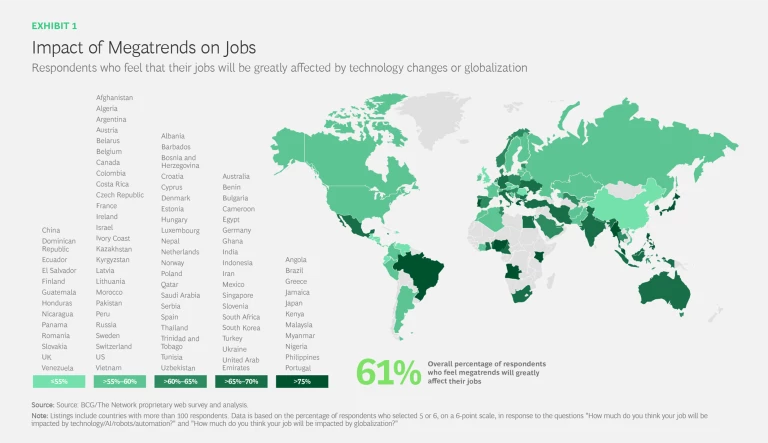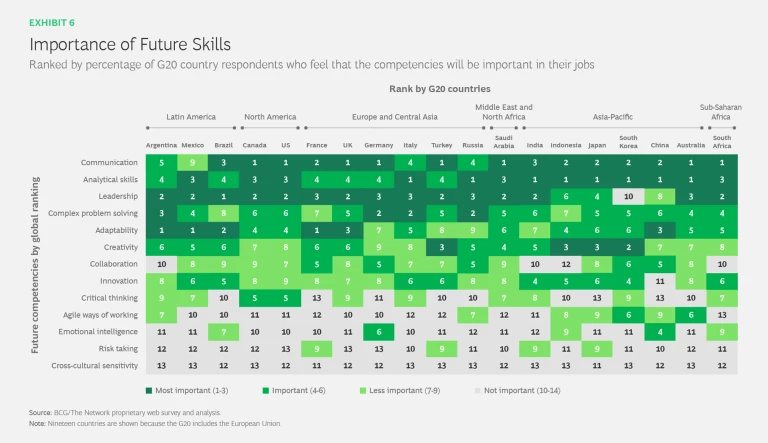This report is the latest in the Decoding Global Talent series about workforce changes and skills of the future.
C hange is coming and the workforce knows it. Sixty-one percent of people believe that global megatrends greatly affect their jobs and will continue to do so. As a result, many devote significant time to refining their skills. The vast majority are also willing to learn new skills to become attractive candidates for completely different jobs.
Sixty-one percent of people think that global megatrends greatly affect their jobs.
These insights come from one of the largest ever global surveys of labor trends and work preferences: 366,000 people in 197 countries surveyed by Boston Consulting Group and the online international recruitment company The Network for our comprehensive Decoding Global Talent report series.
Global megatrends are transforming more and more aspects of work and, in so doing, changing the skills that people need for their jobs and redefining the jobs that will be needed and where . We explored two specific megatrends—technology changes and globalization—and two possible reactions to them. One is people’s willingness to adopt new skills for their current positions, what we refer to as upskilling. The other is their willingness to pick up new skills for a completely different job, commonly known as reskilling.
To excel in the future, people believe, they should master a mix of cognitive and interpersonal skills so that they can think analytically as well as communicate and collaborate with supervisors and coworkers. When they need training on new skills, they prefer to learn on the job, on their own, and through online classes and mobile apps to other, more traditional options.
Attitudes toward upskilling and reskilling , demographic and regional differences in those attitudes, and people’s preferences for how they like to learn all have implications for companies and governments. Companies must be aware of these trends so that they can future-proof their workforce and make themselves more attractive to prospective job candidates. Government policymakers must take them into account so that they can support job-training initiatives and other programs to keep people employed and prepare young people for the workforce. And individuals who want to remain in demand in a changing job market must take responsibility for keeping their skills up to date and accept that job-related training is a career-long commitment.
Megatrends’ Impact on Work
The survey gathered demographic information on 366,000 respondents, making it possible to analyze global attitudes along a variety of parameters, including by nationality, age, gender, education level, and job. (See the appendix .) We also performed a regression analysis on key variables that influence time spent on learning and willingness to upskill and reskill in order to validate some of our initial findings. And we conducted follow-up interviews with a number of respondents.
We found that across the globe, people are aware of changing ways of working. An average 61% of respondents believe that their current positions will be greatly affected by technology change or globalization. (See Exhibit 1.)
Among the countries where respondents feel the greatest impact of the megatrends on their jobs, we found both developing and developed economies: several African countries as well as Japan and some Mediterranean countries.
Similarly, respondents who feel the least affected by megatrends live in places with very different economic situations: some Central American countries, the UK, and China.
In addition, digital experts , who we describe as those with advanced or high-level digital skills, are significantly more likely (73%) than the average to believe that megatrends will affect their jobs. Other people who feel that megatrends will greatly affect their work have jobs in digital and analytics (76%), IT and technology (73%), marketing and communication (66%), science and research (66%), and media and information (66%).
Studying the impact of the two megatrends in more detail, we find that slightly more people believe that job changes will be driven by new technologies such as automation, artificial intelligence, and robotics (49%) than by aspects of globalization such as trade and outsourcing (45%). (See Exhibit 2.) For instance, technology change is seen as a greater force than globalization in Russia (47% vs. 38%), China (42% vs. 36%), and Germany (55% vs. 50%). Globalization is considered the larger factor in Japan (59% vs. 50%) and Saudi Arabia (52% vs. 43%), for example. And residents of some countries such as Brazil, Kenya, and India feel that both megatrends will greatly affect them, while residents of countries such as the UK, US, and Canada tend to feel that neither one will affect them very much.
Willingness to Learn
If people feel that their livelihoods are affected by global megatrends, it follows that they are willing to devote time to learning new skills in order to stay relevant in their jobs. We found that close to two-thirds of respondents (65%) spend significant time on learning each year, from a few weeks to a few months.
We also found substantial regional differences in people’s willingness to learn. Accordingly, we group countries into four categories: proactive adapters, bystanders, hesitators, and intrinsic learners. (See Exhibit 3.)
Proactive adapters believe megatrends will strongly affect their employment, and that could explain why they already spend significant time on learning. In Nigeria, 85% of respondents devote significant time each year to upskilling. Other proactive adapters include Kenya and Brazil.
By contrast, residents of bystander countries don’t believe megatrends will have a significant impact on their jobs, and that could lead fewer of them to spend a significant amount of time on learning. In Belgium, France, and Austria, less than 43% of people spend significant time each year on learning. Other bystander countries can be found in Western Europe and North America, among them Switzerland, the UK, Sweden, Canada, and the US.
Somewhere between proactive adapter and bystander countries are countries where the majority of respondents believe current economic trends may affect their jobs, but even so they have yet to invest much time in training. These hesitant respondents, who may have opted to take a wait-and-see approach, come mainly from Western European countries, including Portugal, Slovenia, and the Netherlands. Germany also falls into this category, with the lowest percentage of people, only 38%, who spend a few weeks or more on training per year. (See Exhibit 4.)
Other respondents learn for the sake of learning. Although they do not believe that megatrends will have a significant impact on their livelihoods, they invest more than the average amount of time on learning. Countries with many intrinsic learners include China and Vietnam.
People’s devotion to learning also varies by their type of employment. Respondents are more likely to spend significant time on learning if they work for themselves, either because they freelance (74%) or are self-employed in some other capacity (70%). Sixty-two percent of people who are full-time employees spend a significant time on learning, a still substantial amount.
People’s profession and expertise also affect the amount of time they spend on learning. The vast majority of digital experts (76%) spend a significant amount of time on learning. In line with that, 72% of people who work in IT and technology or in science and research professions spend a few weeks or more a year developing on learning.
Most digital experts (76%) devote a significant amount of time to learning.
When Tomilola Abiodun, 28, was hired as a product marketing manager job with a major US technology company in Seattle, she spent three of her first five weeks there on job-related skills training. Abiodun, who moved to the US from Nigeria to get an MBA, began picking up new skills even before she was hired. She took online classes in cloud computing and the SQL programming language through her university’s library and an online platform. “Even if you only invest one hour in something that might not be relevant for you now, it will certainly be at some point in the future,” she says.
Learning Preferences
New technologies and new ways of working have influenced how people prefer to learn. When people need to learn new job skills, they choose self-directed methods such as studying on their own (63%), on-the-job training (61%), and online training, such as taking courses through online platforms and using mobile apps (a combined 54%). All of these are preferred over learning through traditional avenues including conferences (36%), educational institutions (34%), and government-sponsored programs (7%). (See Exhibit 5.)
People in East Asia are especially keen on digital-based learning, with eight out of ten preferring mobile apps or online courses when they need to train on new skills. In other parts of the world, people remain wedded to more traditional settings for learning. For example, traditional educational institutions are among the top three learning channels for respondents in Latin America, Sub-Saharan Africa, the Middle East, and North America. And attending a conference or seminar is still one of the top three ways that residents in Europe and South Asia like to learn.
In the past year, Manuel Milliery, 31, took an online management innovation course through the London School of Business and an executive master’s in business management at ESSEC in Paris, where he lives. Milliery, a design thinking management consultant for a US consulting firm, appreciated the access that the online course gave him to case studies and to learning new aspects of innovation. But he enjoys taking courses in person for the connections he makes. “Talking to the people in the course is helpful in two ways, to get some help on work problems but also to work on myself as a brand and to network,” he says.
Future Competencies
To excel in the future, people worldwide believe, they will need to be multifaceted so that they can be both good collaborators and critical thinkers. They place the greatest importance on having solid communication and analytical skills, followed by improving their leadership and complex problem-solving skills. (See Exhibit 6.)
Jesus Alvarez Manzanilla, 33, is a marketing specialist in Amsterdam. He switched jobs in early 2019 to join a 50-year-old leasing and transportation company and help with its digital transformation initiative, which involves applying AI, machine learning, and other automation to systems used in the company’s 32 locations worldwide. Now that Manzanilla is managing other people, some of the three hours a week he spends on training is devoted to improving his emotional intelligence. “When you manage people, it makes it easier if you are a person who listens, who understands, is patient, and asks the right questions,” Manzanilla says. “You need to be able to explain why you believe something is right or wrong. I am working on this now.”
The particular competencies that respondents see as important for getting ahead in their jobs vary on the basis of where they live. Respondents in Latin American countries such as Mexico and Brazil place more importance than the average on being adaptable and innovative. People living in the US and Canada place more importance than the average on being critical thinkers, and residents of China and Germany do likewise for emotional intelligence.
In addition, respondents in France and the UK believe that it’s important to be adaptable, whereas in Australia and South Korea, people place more importance than those elsewhere on understanding agile ways of working. Residents of Asia-Pacific countries generally see analytical skills as the most important future competency to develop, followed by communication and innovation skills.
The competencies that people believe will be crucial to have in the future also differ depending on what they do for work. People with jobs in the digital, IT, technology, finance, and legal fields believe it’s most important to have hard skills such as analytics and complex problem solving. By contrast, people who work in social care, the service sector, and manufacturing feel that interpersonal skills such as communication, leadership, and adaptability will be key to their future job success. And fittingly, people working in media and information job roles prioritize creativity.
Willingness to Reskill for a New Job
In addition to developing skills to stay competitive in their current role, the vast majority of respondents worldwide are also willing to learn new skills in order to qualify for a new job: 67% are open to reskilling under any circumstances, and 29% would reskill if they encountered serious roadblocks in a job search. (See Exhibit 7.)
Willingness to reskill varies by region. We found that respondents in Latin American countries are the most ready to switch jobs, with 84% willing to learn new skills if doing so made them more employable for new roles. Respondents from Europe were the least open to change, with an average of 63% reporting a willingness to reskill. Willingness to reskill is especially low among respondents from Germany (53%), Iran (46%), and some Central and Eastern European countries. (See Exhibit 8.)
People’s openness to a career change also varies based on their current occupation. Regardless of where in the world they live, respondents working in sales, administrative, and service jobs are the most willing to reskill for a different role. People who work in the science, IT, and legal fields are slightly less open to reskilling for a new job. However, we know from the significant amount of time they spend developing their skills that they are invested in staying competitive within the scope of their current occupation.
We also found a connection between respondents’ attitudes toward reskilling and their education level and age. The more educated people are, the less willing they are to consider retraining for a different role, perhaps because of the amount of time they have already invested in obtaining their current skills. Respondents ages 21 to 40 are the most willing to reskill. The least willing are people age 20 or younger, who may still be in school or learning the skills they need for a first job, and those 50 or older.
In fall 2019, Anne Granelli, 48, was preparing to begin a new job as the head of a health care center near Gothenburg, Sweden. In the past year, the only time that Granelli devoted to training was attending an equipment supplier briefing. She expects that to change because her new employer is keen for her to learn and provides opportunities to do so. “They want me to attend a course at Gothenburg University on personal improvement and the psychology of change, as well as on leadership. I absolutely see the value in that,” she says.
How Companies, Governments, and Individuals Can Adapt
The modern workforce expects change and is willing to adapt and train to be ready for it. Companies and governments must promote upskilling and reskilling to help people prepare and to avoid a two-tiered workforce in which some workers are ready for change and others are not. Individuals must take charge of their own skills development to remain competitive in a fast-changing labor market.
Implications for Companies
Companies must understand how the megatrends affect their business so that they can help employees gain the skills they’ll need in the future.
Create a strategic workforce plan and complement it with strategic skills mapping. Companies should run strategic workforce demand-and-supply simulations to quantify mid- and long-term talent gaps. They should complement this by classifying current skills needed for different jobs and mapping them against future needs on a regular basis. Doing this will allow them to assess what kind of upskilling they might need to do and how best to target their efforts. To create a database of employee skills, companies can use emerging tools such as game-based assessments of skills and behaviors or collect data on skills from social media sites.
Launch targeted upskilling programs and offer new ways of learning. Once companies have pinpointed employee skill gaps, they can develop learning interventions to bridge those gaps. Interventions should take full advantage of emerging learning technologies and techniques, such as digital nudges delivered through mobile apps, augmented reality-based trainings, game-based learning, and micro-learning, which involves lessons that run only a few minutes and can be incorporated into the normal work day. Companies should also customize best-practice learning methods to individual employees through things like personalized learning platforms.
Establish an enterprise-wide upskilling culture. Training and development programs are likelier to succeed if leadership promotes a learning culture, if the right incentives are in place for employees to learn, and if HR processes such as talent management and performance assessment are aligned with upskilling efforts. Best-in-class companies encourage employees to adopt a continuous-growth mindset and learn on the job, provide opportunities for people to take time off for learning, and have managers act as training coaches. Companies can use learning contracts , detailed training plans that employees and their managers review and sign, to ensure that both parties follow through on learning goals. Finally, employers must regard skill building as a long-term investment and, if necessary, adjust financial decision-making principles accordingly.
Extend upskilling efforts to the wider society. To build the workforce of tomorrow, companies should take responsibility for training future as well as existing employees. As part of this effort to prepare younger generations and potential candidates, companies can collaborate with government agencies and educational institutions to offer apprenticeships or vocational training that combines classroom study with practical experience. They could launch early-education initiatives to motivate young people to consider entering in-demand careers, such as offering coding lessons for young girls to encourage them to enter STEM fields.
To build the workforce of tomorrow, train future as well as existing employees.
Implications for Governments
Although government-run training isn’t a popular learning option in most parts of the world, governments can still play an important role in supporting citizens and bolstering the economy by collaborating with industry and educational institutions on upskilling and reskilling initiatives.
Continuously forecast workforce and skills gaps. Just as companies need a strategic workforce plan and skills map, so do govern-ments. They should collab-orate with the corporate sector to develop industry-wide skills forecasts and standards and then build a quantitative model for forecasting workforce demand and supply. This will identify key workforce gaps and skill mismatches in the economy that can be addressed proactively.
Take an active role in matching skills and jobs. Once policymakers have determined the areas in which a skills imbalance is the most severe, they should make a conscious effort to bridge the gaps; they can partner with the business community or educational institutions to do it. Around the world, governments have launched such efforts. Among them: the Skill India Mission, a large-scale program to upskill millions of Indians through public-private partnerships, and the Singapore government’s SkillsFuture program, a national initiative to provide citizens with career-long learning opportunities.
Future-proof the education system. Public-sector educators at all levels should refresh curricula to include hard skills needed in the future, such as coding and artificial intelligence, and soft skills that today’s workers deem to be important for advancement, including communication, collaboration, creativity, problem solving, and critical thinking. Educators should rethink how classes are offered to appeal to people’s different learning preferences, including combining offline and online methods and developing approaches for lifelong learning.
Governments should also ensure that young people have the information they need about the future job market and that they have a chance to learn required skills on the job. For example, after Swiss students finish high school, they can choose between going to college or doing a two- or four-year employer-paid apprenticeship, after which they can enter the job market or continue their studies.
Establish individual learning accounts. Governments can cultivate a lifelong-learning mindset by helping employees save for training purposes. A system of individual learning accounts jointly financed by employers, government, and employees does just that. Employees can pay for training and development from the account, which goes with them if they move to a new job, giving them more control over their career development. In France, private-sector employees get a personal training account with their first job and can use it to pay for a wide variety of approved courses until they retire.
Governments can cultivate a lifelong-learning mindset via learning accounts.
Offer incentives for corporate spending on learning. Governments can use tax breaks to encourage organizations to devote resources to training. In Finland, companies can write off the expense of any skills training that employees need to keep their jobs, and individuals can deduct expenses in excess of a certain annual amount incurred to gain professional or vocational skills.
Remove barriers to nontraditional careers and support new talent pools. To support a flexible labor market, national governments can remove barriers to work-related mobility by recognizing the qualifications, certifications, or accreditations that a job candidate earns in a different country, industry, or job role. Likewise, they can make it easier for companies to hire people who are willing to relocate for work by streamlining visa regulations, social integration, and other potential roadblocks. Policymakers can also support disadvantaged talent pools’ access to the labor market, including providing upskilling, networking, and job placement to minorities, working mothers, and older workers.
Implications for Individuals
People need to be their own best coaches for the skills that they need for their jobs today and in the future.
Have a plan. Strategic plans work for people as well as they do for companies and governments. Everyone who works should have a career plan that maps out the type of work they want to do along with the skills they need in order to remain competitive in the marketplace. A plan should start with determining what skills give them an edge over other people with comparable jobs and what else about their “personal brand” separates them from the pack. And it could include concrete actions they should take to advance their career, including digital tools to learn, courses to take, projects to engage in, and relationships to cultivate.
Make a habit of continuous learning. Freelancers already devote more time than the average to training, presumably to improve their employability. People with full-time jobs can adopt a similar mentality and always be thinking about the skills they need. Workers can ask for assignments that would require them to adopt new skills, or they could launch side projects to gain new expertise. People should also take advantage of courses offered by an employer or professional organization, or enroll in online classes to pick up a new skill or two.
Adopt a lifelong learning mindset. In today’s fast-paced labor market, it’s crucial to know how to adapt to changing conditions and ways of working. Learning the skills needed for multiple professions over the span of a career might soon be the norm. Be open to shifting to another job, industry, or country if needed.
The world of work is changing. Technology advances and globalization are two megatrends that are seeing to that. The skills that people learn at the beginning of their careers aren’t necessarily what they will need for the same job in the future. Upskilling, reskilling, and lifelong learning might sound like buzzwords, but they mean business. For organizations to remain competitive and national economies to stay strong, companies and governments must help people adopt the skills they need to do their jobs today and in the future. To stay relevant in their current positions and be attractive to potential employers, people need to understand how progress is affecting their job and take time to train accordingly.




















